An apology: Something happened to this post whereby much of it got underlined and nearly deleted. At the risk of losing it entirely, I am keeping it as is. Sorry for the inconvenience of having to view everything as if it were a book title.
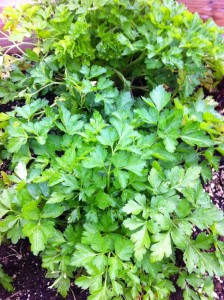 |
Winter parsley is an exalted version of its already-awesome self.
|
It’s always heartening to walk through a garden in winter and realize, “Hey, there is a lot to eat here.” Now that said, some readers from Parts Elsewhere may not acknowledge that the relatively mild weather we Portlanders experience November through March actually merits the name “Winter”. Fair enough. Still, we get soggy and cold here, and the plants, if not severely tested by constant frost and snow, do have to contend with repeated light frostings and the miseries of low light.
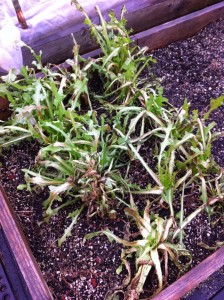 |
| My expectations upon viewing this Cardoncello Barese endive fell flatter than a Patriot’s football! |
Let’s start our review of the winter/non-winter garden by deflating a balloon (I wrote this draft prior to any news about the Patriots, I swear!) that I had just puffed up in late fall, that of the Cardoncello Barese endive. A recent blog post saw me so excited that I had even broken out into song at both the beauty of the Italian and the prospect of such a bold, new endive coming into my ken. Well, even with our mild version of winter, Cardoncello Barese has disappointed by showing lots of leaf browning from the constant soak. This is not the herioc, steroidally dandelionic endive I was expecting. Oh, well. What I have noticed is that the heads that were shielded from rain have held up better, so that is some guidance for the future. I did try the cut-the-mucky-greens-back-severely-and-see-what-happens approach, so we’ll see what happens.
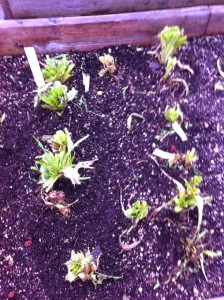 |
| It’s bad economics to expect severe cutbacks to promote healthy growth, but gardening ain’t economics. Here’s to a second chance for Cardoncello Barese. |
Looking better are the Tres Fine endives growing mostly protected (except when the wind whips that protection off) and looking thick, bushy and blanched. LOVE these guys, and you can’t do better with these than when frost has taken some edge off their bitterness. I can eat (and have eaten) whole salads of just this endive in winter, with a nice, sweet, jam-based dressing (think raspberry balsamic vinaigrette) to play to the bitter of the endive. Yum, yum.
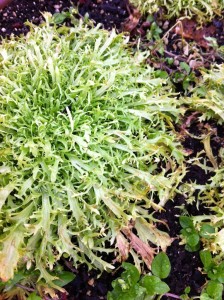 |
| Tres Fine endive with damaged outer leaves but a heart of gold. I know some humans who fit this description as well. |
The surprise of the winter has been a total newcomer, Tokyo Bekana. Full disclosure: I ordered these seeds on a lark, just trying things for diversity’s sake and not expecting much. I have been bowled over by the sweet, mild Chinese cabbage taste and the amazing frost tolerance of this seemingly delicate, tender crop. It has a few yellowing, outer leaves, but all the central growth is bright green with snow white mid-ribs. Plus its winter-sweetened taste keeps me going back for “just one more bite” whenever I’m close to the bed. I am certainly growing more of this next year, especially for my home garden.
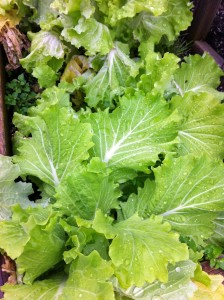 |
| Tokyo Bekana. Never did I expect this Chinese cabbage to fare so well during the winter. Taste is superior. |
I’ve also been jonesing since the fall on the interestingly-shaped buckhorn plantain, which I believe is the same thing offered in the Johnny’s seed catalog under the name Minutina. This is a crop that we will not repeat on the rooftop but that I will grow at home. Leather Storrs, the Noble Rot chef, hates the stuff, finding it flavorless and worthless. I, on the other hand, find it of value to my winter salads mainly for its textural and visual contribution. I’ll be the first to say that its flavor won’t really be memorable (not will it be offensive). It’s earthy and plain, sort of like chickweed, but I find it the perfect base layer for a salad that can then be topped with tastier and more costly baby greens. It delivers hearty crunch, and it’s lance-shaped leaves with interesting prongs do double duty as objet d’art on the plate. Yet another instance where chef and gardener sometimes part ways, but I bow to my boss and bring it home to my garden. Another plus: it appears impervious to cold, and even the Johnny’s catalog (based in Maine) says the same, and those Mainiacs, unlike we Portlanders, know cold!
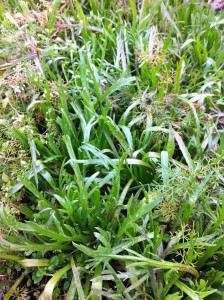 |
| The bold shape of Buck’s Horn Plantain or Minutina. My go-to for crunchy, earthy salad maximizer. Kind of like the Hamburger Helper of winter salad greens. |
Finally we make our way to the visual star of the winter: Dark Purple Mizuna. While you can get a lot of green (with streaks or shades of purple) in this crop during the summer, winter seems to hold the key to purpling it up. With winter’s coming the leaves thicken as well, so it goes from being a very thin-leaved summer lightweight, to a really substantial and hearty member of the salad plate club. It doesn’t grow as vigorously as regular mizuna during the season, so I plan to use it more next year solely as a fall-sown scatter crop, something I toss willy-nilly into the autumn garden and let fill in the interstices of what’s already standing.
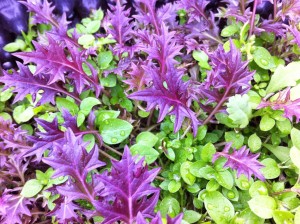 |
| Dark Purple Mizuna, with its holly-like leaves, frolicking amidst the chickweed. That is some satisfying visual drama! |
Yes, winter has its own delights in the garden, which include thick, substantial leaves, hearty flavors, vivid colors, and bitter greens with their edgy bite taken off. Yet, even as I speak of winter I must acknowledge our parallel season of non-winter, permitting me little time to revel in the muscularity of these frost-tested leaves and flavors. Our mild climate means that soon it will be time to focus on the tender, the fresh, and the plentiful crops which grow as weather warms. Indeed they are already growing indoors under lights, and before long they will be back featured on these cyber pages.

